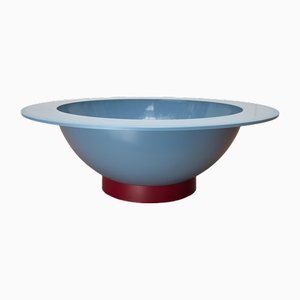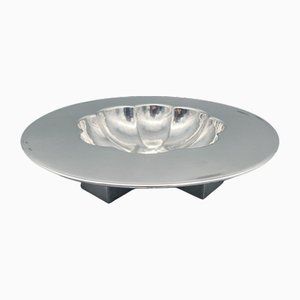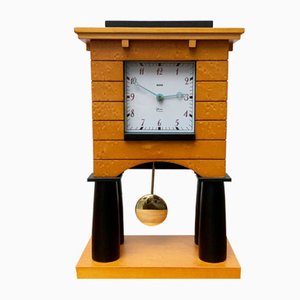
One of the most prominent postmodern architects of the 20th century, American architect and industrial designer Michael Graves produced a prolific body of work spanning office buildings, retail spaces, hospitals, and houseware products. Over the course of his career, in fact, Graves designed more than 350 buildings and over 2,500 products.
Born in Indianapolis, Indiana in 1934, Graves earned a Bachelor’s degree in architecture from the University of Cincinnati in 1958. He went on to obtain a Master’s degree in architecture from Harvard University in 1959. In 1960, Graves received the Rome Prize, and spent the following two years studying architecture at the American Academy in Rome. Upon returning to the U.S. in 1962, he began an architecture professorship at Princeton University, which lasted for 39 years. In 1964, he founded his own architectural firm—Michael Graves & Associates—in Princeton, New Jersey.
During the 1970s, Graves became known as one of the “New York Five,” a group of young, New York-based architects that championed a new and pure form of modernism, referencing the minimalistic aesthetic of Le Corbusier in the 1920s and ’30s. Alongside members Peter Eisenman (born 1932), Charles Gwathmey (1938-2009), John Hejuk (1929-2000), and Richard Meier (born 1934), Graves advocated this aesthetic in works like the Snyderman House in Fort Wayne, Indiana (1972)—a single-family dwelling that was celebrated by critics and architects as a refreshing and novel example of modernism.
In the 1980s, Graves helped shift the architectural conversation from pure forms to a new language of hybrid, namely postmodern design. He espoused a humanistic approach, bringing color and art back into architecture. During this period, famed Italian architect Ettore Sottsass asked Graves to join his artistic collective Memphis, a tribe of radical, like-minded designers who questioned the conventional view of design and who helped to define the postmodern style. Graves contributed to Memphis with several designs, including the Plaza Dressing Table (1981) and the Stanhope Bed (1982). Graves’ seminal architectural work came in 1982, with the opening of Oregon’s Portland Building. The building received mixed reviews, but Graves’ postmodern building was recognized for its historical importance, earning an award from the American Institute of Architects in 1983.
During the 1990s, Graves collaborated with the American retail chain Target on a home goods line that helped solidify the notion that great design should be available to everyone. Some of Graves’ peers saw the partnership as a commercial sell-out, however Graves believed design could be used as a great corporate strategy. When asked whether he worried about injuring his reputation, Graves replied simply, “Just the opposite. It was my hope to do that.” In the years since, several other noted designers have followed suit by collaborating with the retail giant, including the likes of Dror Benshetrit, Marcel Wanders, and Karim Rashid, among others.
In 2003, Graves became paralyzed from the waist down due to a spinal cord infection. Soon after, he became an advocate for health-oriented design. Using design to improve healthcare experiences for patients, families, and clinicians, Graves was named one of the Top 25 Most Influential People in Healthcare Design by the Center for Health Design, and, in 2013, President Obama appointed Graves to the United States Access Board, which is devoted to accessibility for people with disabilities.
Graves’ most prominent architectural projects include: the Humana Building in Louisville, Kentucky (1982), Team Disney Building in Burbank, California (1986), Detroit Institute of Arts in Michigan (1990), Ministry of Health, Welfare and Sport in The Hague (1993), Denver Public Library (1995), Indianapolis Art Center (1996), and an expansion of the Whitney Museum of American Art in New York, which was proposed in the mid-1980s, but never realized.
He has designed projects for the likes of Dansk, Disney, JC Penney, Swid Powell, and many other globally recognized brands. His most notable design collaboration, however, was with the Italian brand Alessi; the partnership lasted decades and Graves produced more than 150 products for the company in that time. His famous whistling bird 9093 Kettle (1985) became the Alessi’s bestseller with more than two million sold to date.
Over the course of his career, Graves received several prestigious awards and accolades, including the National Medal of Arts from President Clinton in 1999, the AIA Gold Medal in 2001, the Richard H. Driehaus Prize in 2012, and the National Design Award for Lifetime Achievement in 2015. Graves was the first architect to be inducted into the New Jersey Hall of Fame in 2010 as well as the first recipient of the Michael Graves Lifetime Achievement Award from the New Jersey AIA. Notably, Graves received fourteen honorary doctorates, and was a member of the American Academy of Arts and Letters, as well as a Fellow of the American Institute of Architects.
Graves passed away in Princeton in 2015 at the age of 80.










